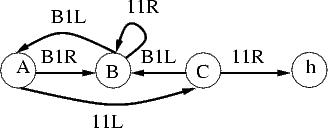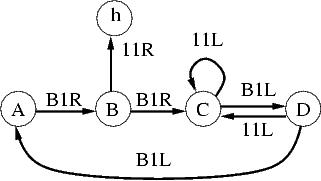The Busy Beaver,
the Placid Platypus and other Crazy Creatures*
James Harland, School of CS&IT, RMIT
Seminar 13th May, 2005
James Harland, School of CS&IT, RMIT
Seminar 13th May, 2005
*Thanks to Jeanette Holkner,
Michael Winikoff and
Sandra Uitdenbogerd
for assistance with zoological names and descriptions
IntroductionBeaver machines are a particular type of Turing machine:
- Deterministic (at most one transition for any state and input symbol)
- Two-way infinite tape
- Tape alphabet is only blank (B) and 1
- Initially tape is entirely blank
- Single halt state
Known busy beavers
- Cases n = 1,2,3 solved by Lin and Rado in 1960's
- Case n = 4 solved by Brady in 1970's
- Cases n = 5,6 had some monster machines found in 1990's and 2000's, but still open
ff(n): maximum number of state transitions made by a terminating beaver machine with n states (often written S(n))
prod(M): number of 1's printed by machine M (undefined if M does not halt)
Hence bb(n) is the maximum value of prod(M) for all n-state machines M.
Naturally ff(n) ≥ bb(n) and is typically much larger. Possible that the values of bb(n) and ff(n) arise from different machines.
| n |
bb(n) |
ff(n) |
| 1 | 1 | 1 |
| 2 | 4 | 6 |
| 3 | 6 | 21 |
| 4 | 13 | 107 |
| 5 | ≥ 4098 |
≥ 47,176,870 |
| 6 | ≥ 1.29×10865 | ≥ 3×101730 |
| 7 |
.... |
.... |
Consider that a 6-state machine can be represented in 55 bits ... (and 10865 takes about 2,800 bits)
| 3-state busy
beaver |
4-state busy beaver |
 |
 |
| 5-state busy beaver candidate | 6-state busy
beaver candidate |
 |
 |
Non-computability
The busy beaver function is non-computable, because it grows faster than any computable function!
Proof: Let f be any computable function.
f computable ⇒ so is F(x) = Σ 0 ≤ i ≤ x f(i) + i 2 ⇒ k-state amphibian machine MF : x 1's → F(x) 1's
Consider M: X then MF then MF where X: blank → x 1's. Note X has x states.
M behaves as follows:
- M first writes x 1's
- M mimics MF , writing F(x) 1's on the tape
- M mimics MF again, writing F(F(x)) 1's on the tape
Now F(x) ≥ x 2 > x + 2k for x > m, and F(x) > F(y) when x > y, and so F(F(x)) > F(x+2k) > f(x+2k)
So bb(x+2k) ≥ x + F(x) + F(F(x)) > F(F(x)) > F(x+2k) > f(x+2k)
Hence, as f was arbitrary, bb is not computable ◊
Green (1964): for any computable f, f(bb(n)) < bb(n+1)
Hopefully this doesn't apply for n = 5, as otherwise for f(m) = m m we get bb(6) > 4098 4098 ≈ 10 14,804 (!?!?!)
Searching for bb(5) and bb(6) (aka the hunt for the great white whale :-)
How many machines are there?
- n-state machine, 2n transitions, 2 outputs, 2 directions and n+1 possible new states ⇒ (4 (n+1)) 2n
- only ever one halt state ⇒2n × (4n) 2n-1
- fix first transition (output 1, direction R, state 2, not halt) ⇒(2n-1) × (4n)2n-2
For n =5 we "only' have to search through 230,400,000,000 = 2.3 ×1011 machines ...
Naive generate and test won't work; the trick is how to incorporate the test into the generation.
| Input |
1 |
2 |
3 |
4 |
5 |
| B |
O1 = 1, D1 = R,
N1 = 2 |
not (D3 = R, N3 =
2),
N3 ≠ h |
O5, D5, N5 | O7, D7, N7 | O9, D9, N9 |
| 1 |
O2, D2, N2 |
O4, D4, N4 |
O6, D6, N6 | O8, D8, N8 | O10, D10, N10 |
Some "global" constraints can be used as well, such as avoiding N3 = 3, D3 = R, N5 = 2, D5 = R.
Tree normal form:
- emulate machine as the transitions are generated
- add the halt state only when there is only one "slot" left
- generate states in numerical order
- detect loops as early as possible
Using equivalences and some other reduction techniques, it seems the number of 5-state candidates is "down" to 69,471,096 ie 6.9 ×107
Loop detection is critical! Mining the data for the 117,440,512 machines with 4 states:
| ones |
5 |
6 |
7 |
8 |
9 |
10 |
11 |
12 |
13 |
| machines |
73,617 |
13,029 | 1981 |
475 |
79 |
13 |
6 |
5 |
2 |
- 89,207 machines terminate and print at least 5 1's
- only 2,561 machines terminate and print more 1's than the 3-state busy beaver
- loops abound!
- simple loops 1 {D} B → 11 {D} B → 111 {D} B → 1111 {D} B → ...
- configuration repetition BB1 {C} 11B →* BB1 {C} 11B
- binary counters BB1 → B1B → B11 →1BB →1B1 → 11B →111 → ...
- Christmas trees 1B1 → 11B11 → 111B111 → 1111B1111 → ...
- others ...
- should generate an
(inductive)
proof of non-termination in each case
Code
- currently about 1,000 lines of Ciao Prolog (around half of which is redundant)
- will be cleaned up and published at some point
- naive emulation seems fine
- m1 (below) takes about 90 seconds on my PC
- m3 (below) takes about 50 seconds
- all others 20 seconds or under
Other Creatures
Revisit first table above
| States |
Name |
Final Ones |
Maximum Ones |
Hops |
Diagram |
| 3 |
bb3 |
6 |
6 |
14 |
 |
| 3 |
lb3 |
6 |
6 |
11 |
 |
| 3 |
ff3 |
5 |
5 |
21 |
 |
| 4 |
bb4 |
13 |
13 |
107 |
 |
| 4 |
lb4 |
13 |
13 |
96 |
 |
| 5 |
m1 |
4098 |
12,288 |
47,176,870
|
 |
| 5 |
m2 |
4098 |
6,144 |
11,798,826
|
 |
| 5 |
m3 |
4097 |
23,554,764
|
 |
|
| 5 |
m4 |
4097 |
11,798,796
|
 |
|
| 5 |
m5 |
4096 |
11,804,910
|
 |
|
| 5 |
m6 |
4096 |
11,804,896
|
 |
|
| 5 |
m7 |
1471 |
2,358,064
|
 |
|
| 6 |
ddd |
1.29×10865 | 3×101730 |  |
n-state machine prints m 1's ⇒
- bb(n) ≥ m
- at most n states are needed to print m 1's
Question: what is the minimum number of states needed to print m 1's?
We call this function the placid platypus which we denote by pp(m).
An n-state machine which prints m 1's thus shows that bb(n) ≥ m and pp(m) ≤ n.
pp(m): minimum number of states of a terminating beaver machine which prints n 1's
ww(m): minimum number of state transitions made by a terminating beaver machine which prints n 1's
| n |
1 |
2 | 3 | 4 | 5 | 6 | 7 | 8 | 9 | 10 | 11 | 12 | 13 | 14 | 15 | 16 | 17 | 18 | 19 | 20 | ... |
| pp(n) | 1 | 2 | 2 | 2 | 3 | 3 | 4 | 4 | 4 | 4 | 4 | 4 | 4 | 5? | 5? | 5? | 5? | 5? | 5? | 5? | ... |
| ww(n) | 1 | 1 | 5 | 4 | 7 | 11 | 12 | 14 | 19 | 30 | 40 | 53 | 96 | ?? | ?? | ?? | ?? | ?? | ?? | ?? | ?? |
Not clear that we can fill in every entry in this table.
Question: Is it true that there is a 5-state machine which prints m 1's for each bb(4) ≤ m ≤ bb(5)?
Note that this is certainly false for the range bb(5) to bb(6).
There are at least 10800 numbers to cover, and "only" (4 × 7)12 = 232,218,265,089,212,416 = 2.3 × 10 17 machines.
So what is the distribution of placid platypus machines?
Consider how one could print 6 1's.
| Name |
States |
Ones |
Hops |
| 4 |
10 |
30 |
|
| 5 |
10 |
26 |
|
| 4 |
12 |
53 |
|
| 5 |
12 |
49 |
|
| lb3 |
3 |
6 |
11 |
| int4 |
4 |
6 |
9 |
| int5 |
5 |
6 |
8 |
| rr6 |
6 |
6 |
6 |




These are all equivalent in some sense. Can we generate the others from the 6-state version?
Mysteries
- Is bb(5) = 4098?
- How to write a better loop detector
- How to generate proofs of
non-termination from positive loop detection
- Productivity for machines which are
- contiguous (tape always of the form B1 *B)
- eager (output is only 1, never B)
- monotonic (no transitions with 1 input
and B output)
- Distribution of 5-state machines between bb(4) and bb(5)
- Platypus numbers, ie those which can be printed by a beaver machine. Known range at present is {1-14,1471, 4096, 4097, 4098, + a handful of large numbers}
- What is the largest continuous range
which can be represented by a terminating beaver machine?
- What is the smallest number that cannot
be printed by a 6-state (resp. 5-state) machine?
- Relationship to 3n+1 problem
- Solve mysteries
- Automatic drawing of machines
- WYSIWYG editor for machines
- Add features to programming suite
(stopping just short of a web browser :-)
- Publish database of 3-, 4- and 5-state machine classes
- Mine the n=5 case for an attempt on n=6 (aka the quest for the demon duck of doom)
- 3-symbol machines anyone?